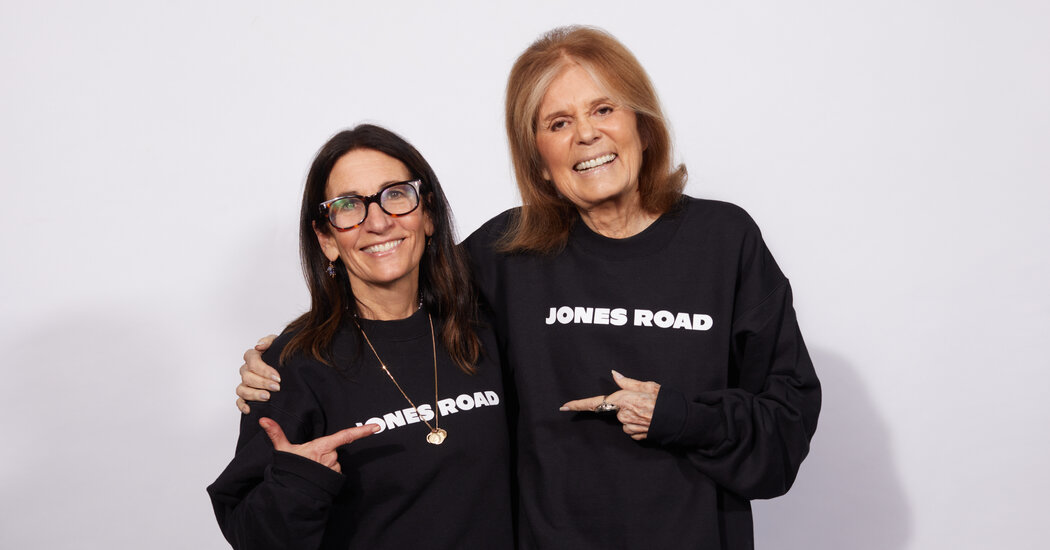Plenty of people still think of Gloria Steinem as the tall, comely babe with honey-toned, center-parted hair who decades ago blazed a trail for second-wave feminism wearing aviator glasses perched on the bridge of her nose.
Some of those people may be heartened to learn that, apart from a few steel-gray hairs and creases, Ms. Steinem, who turned 90 in March, looked much the same when she hosted a discussion this month in support of a new marketing campaign for Jones Road, her friend Bobbi Brown’s four-year-old beauty brand.
“I was ‘the pretty one,’” Ms. Steinem said of her early days as a journalist and activist. Back then, she recalled, there was a widely held perception — or a “ridiculous notion,” as she put it — “that feminists were women who couldn’t get men.”
She was reminiscing in her living room on the Upper East Side of Manhattan with Ms. Brown, 67, and a group of women in a range of professions, among them the actress Naomi Watts, who recently started a line of menopause products; Carla Hassan, the chief marketing officer at JPMorgan Chase; and Suleika Jaouad, the documentary film producer and writer who won an Emmy Award for her video series documenting her experiences with cancer for The New York Times.
The women spoke candidly about any number of irksome issues while discussing Ms. Brown’s new campaign for Jones Road, which she started after the expiration of a 25-year noncompete agreement she signed with Estée Lauder Companies when it acquired her namesake brand, Bobbi Brown Cosmetics.
The largely digital campaign, called “I Am Me,” urges women of varying ages and backgrounds to focus on what they like about themselves — the features that make them distinctive. It is but the latest expression of Ms. Brown’s longtime insistence on bucking industry concepts of how makeup should look and be marketed.
Ms. Brown was brought up in the Midwest, in a culture that preferred leggy blondes, she said in a phone interview on Tuesday. Growing up, she had never considered herself “the pretty one.”
It was only in later years that she arrived at an epiphany. “I finally realized, Dude, you’re a good-looking, short brunette — just go with it,” she said.
Not that she is averse to a few strategic tweaks. She has had laser treatments to remove dark spots and, yes, she has dyed her hair. “I happen to like the way I look with dark hair,” she said.
Ms. Steinem, who has rarely worn lipstick and relies mostly on moisturizer and a bit of eye makeup, said in a phone interview on Wednesday that Ms. Brown’s realistic approach to beauty was commendable.
“Bobbi is not in pursuit of glamour,” she said. “She is encouraging women to embrace who they are — wrinkles, freckles and all.”
A Salon With Snippets of Southern France
At Maison Seventy Seven, a recently opened salon at the western edge of SoHo in Manhattan, there are no junior stylists covered in tattoos, no raucous songs pulsing through speakers and no owners’ names emblazoned on the door.
Those familiar trappings of many high-end hair salons “are not my way,” said Fabrice Gili, a former creative director at Frédéric Fekkai in New York who started Maison Seventy Seven with the hairstylist David Cotteblanche.
Mr. Gili, 55, said they conceived their salon as the antithesis of the high-polish and often forbiddingly austere beauty temples of uptown Manhattan. With a cheery display of straw and felt fedoras at its entrance, a palm tree wall mural and small back garden where customers can get haircuts, the space is meant to conjure a relaxing slice of Mr. Gili’s native South of France.
Informal as its atmosphere may be, Maison Seventy Seven salon still has some trappings of its more genteel counterparts, including a bar stocked liberally with coffees, liquors and Champagne. There is also a selection of products for sale like salves, aromatherapy bath salts, dried floral arrangements and witty ceramics.
Since opening in March, the salon has drawn patrons ranging in age from 20-something to 70-something with its menu of haircuts (starting at $175), single-process color treatments (starting at $170) and highlights (starting at $330), said Mr. Gili, who learned his craft from some of Europe’s leading hairstylists, like Bruno Pittini and Jean-Louis David.
Mr. Gili’s career was also heavily influenced by that of his mother, who owned a salon in Bordeaux that he described as a gathering place for the women of his community.
It was there, he said, that he learned “it is important to touch people in ways they don’t expect, especially to touch them with laughter, which is becoming really rare.”
“A sense of humor is important,” he continued. “Before we fix the hair, we have to fix the brain.”
Sumber: www.nytimes.com












